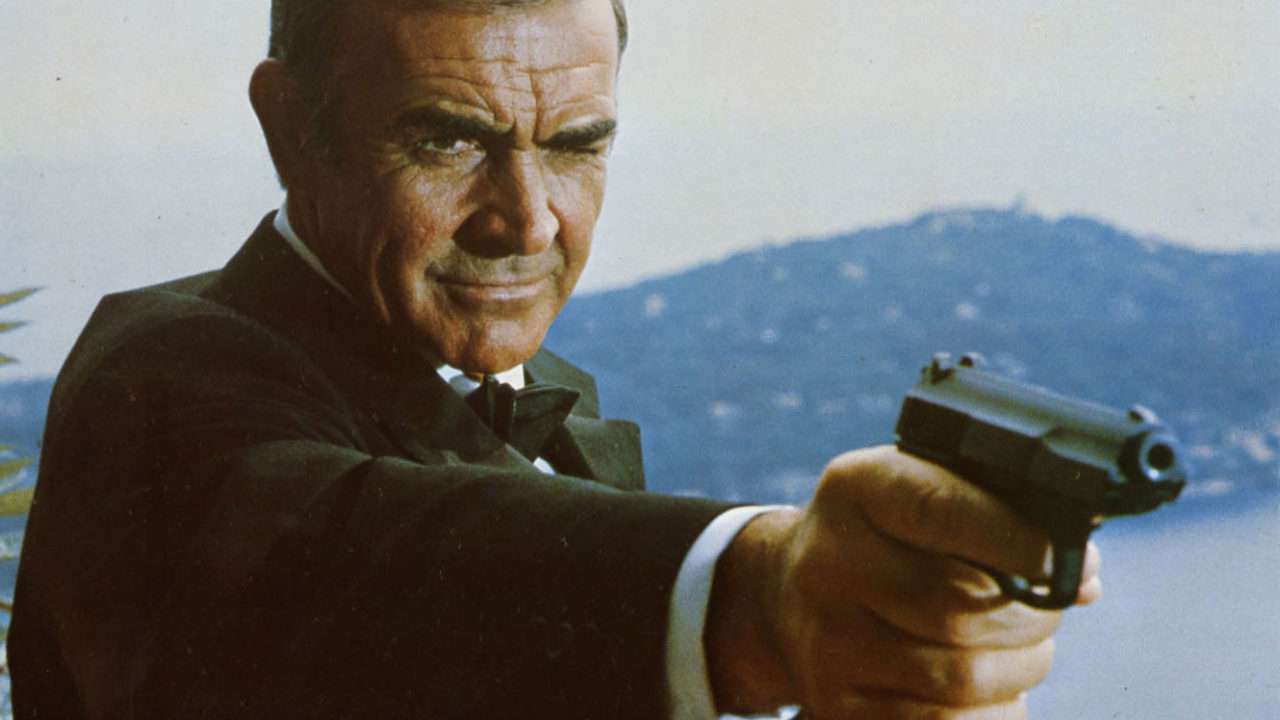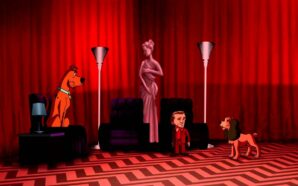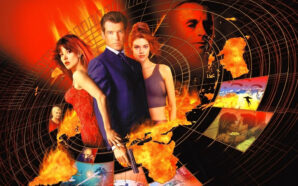As a kid, Never Say Never Again was just another Bond film. While I had some official VHS copies of a few of the films, most in my collection were recorded off the TV, adverts included. The order of the films and the actors playing the famous super spy were a mystery to me, I just liked the stories and the action. It wasn’t until years later when I saw a list of the James Bond films in order that Never Say Never Again became something different in my mind. It turned out it was never in the official canon and wasn’t a ‘true’ Bond film, despite starring Sean Connery. It’s origin dates back to 1965 when Kevin McClory, a producer and co-writer on Thunderball, won a legal battle against James Bond creator Ian Fleming which allowed him to make his own Bond film, although the settlement stipulated that it had to essentially be a remake of Thunderball. And so that’s what Never Say Never Say again is: a re-imagining of Thunderball. It couldn’t be the start of a new rival James Bond film series but rather a one-off instalment that was shunned by the official Eon productions. The film could have easily have been a cheap knock-off, quickly forgotten and not talked about like that 1960’s spoof version of Casino Royale (which I have never and probably will never watch), but one thing propelled the film to popularity, even rivaling the official film series: the return of Sean Connery.
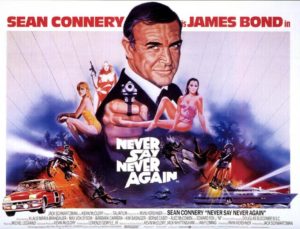 Connery had vowed never to play James Bond again after leaving the official franchise (for the 2nd time) after Diamonds Are Forever, the title of the film itself being a reference to that fact, but the producers drove a dump truck full of cash up his driveway with the promise of creative control and he eventually agreed, knowing for certain there would never be a sequel. Interestingly the producers had originally opened negotiations with George Lazenby to star but they soon tossed him aside when Connery showed interest. The film itself offers some real insight into what makes the franchise tick, especially after going through all 24 of the official films, which is why I’ve left it until last. The rights issues mean that certain signature parts of the Bond franchise can’t be used, like the gun-barrel sequence or the theme music, and so the film is an interesting look into what makes a Bond film a Bond film. Can it capture the vibe without relying on those missing parts of the formula? It also offers the chance to take a take a break from the traditional and do something different. In the end I think Never Say Never Again navigates these tricky waters and makes it through to the other side as a good film. For the most part.
Connery had vowed never to play James Bond again after leaving the official franchise (for the 2nd time) after Diamonds Are Forever, the title of the film itself being a reference to that fact, but the producers drove a dump truck full of cash up his driveway with the promise of creative control and he eventually agreed, knowing for certain there would never be a sequel. Interestingly the producers had originally opened negotiations with George Lazenby to star but they soon tossed him aside when Connery showed interest. The film itself offers some real insight into what makes the franchise tick, especially after going through all 24 of the official films, which is why I’ve left it until last. The rights issues mean that certain signature parts of the Bond franchise can’t be used, like the gun-barrel sequence or the theme music, and so the film is an interesting look into what makes a Bond film a Bond film. Can it capture the vibe without relying on those missing parts of the formula? It also offers the chance to take a take a break from the traditional and do something different. In the end I think Never Say Never Again navigates these tricky waters and makes it through to the other side as a good film. For the most part.
Seeing Connery again now that I’ve gone through all the official films in order was a pleasant surprise and, while he’s still not my favourite Bond actor, he’s great in the film despite his age. Connery was 52 years old and he can still believably beat up the odd henchman but his time with the young Bond Girls is notably awkward. The enhanced pay check and creative control shows in Connery’s performance and he’s better here than he was in Diamonds Are Forever and maybe even You Only Live Twice. I was shocked to learn that Connery was three years younger than Roger Moore, who starred in Octopussy the same year. Moore eventually won the “Battle of the Bonds” with Octopussy making over $10 million more than Never Say Never Again but both films were very successful, with audiences wanting to see a return of Connery’s Bond now that Moore’s continued to stray too far into the farcical.
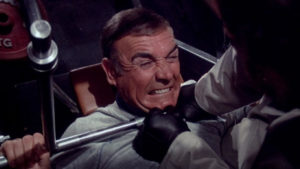 I like the idea of an older Bond and NSNA (I’m already tired of writing out the full title) deals with the character’s aging like never (pun) before. It’s mentioned that Bond mostly teaches now and the opening sequence sees him fail a training exercise; he’s not as quick – or as relevant – as he once was and I like that his age is mentioned, not ignored like the later Moore films. M, played by Edward Fox in a surprisingly bad performance, sends Bond to a health clinic to get him back into shape and that’s where the film’s best scene takes place: a fight between Bond and a large goon played by Pat Roach. If you want your lead character to have to go up against someone in a fist fight in an eighties movie then Pat Roach was always the number one choice: he went up against Indiana Jones in all 3 of the original films. The fight here is great, going from the gym, corridor, kitchen and eventually laboratory of the clinic with great stunts and prop work although it ends rather disappointingly. Bond throws his urine sample in his opponents face which burns like acid for some reason and he dies by slowly backing into shelf of glass objects even though they had both been throwing each other through similar ones multiple times. The first act is great and it’s a shame that the focus on Bond’s age disappears completely once the plot kicks into gear.
I like the idea of an older Bond and NSNA (I’m already tired of writing out the full title) deals with the character’s aging like never (pun) before. It’s mentioned that Bond mostly teaches now and the opening sequence sees him fail a training exercise; he’s not as quick – or as relevant – as he once was and I like that his age is mentioned, not ignored like the later Moore films. M, played by Edward Fox in a surprisingly bad performance, sends Bond to a health clinic to get him back into shape and that’s where the film’s best scene takes place: a fight between Bond and a large goon played by Pat Roach. If you want your lead character to have to go up against someone in a fist fight in an eighties movie then Pat Roach was always the number one choice: he went up against Indiana Jones in all 3 of the original films. The fight here is great, going from the gym, corridor, kitchen and eventually laboratory of the clinic with great stunts and prop work although it ends rather disappointingly. Bond throws his urine sample in his opponents face which burns like acid for some reason and he dies by slowly backing into shelf of glass objects even though they had both been throwing each other through similar ones multiple times. The first act is great and it’s a shame that the focus on Bond’s age disappears completely once the plot kicks into gear.
The plot sees SPECTRE steal two nuclear weapons and blackmail the world’s governments with the threat of total annihilation while Bond tracks the bombs to Largo, a SPECTRE agent who’s second only to Blofeld himself. It’s pretty basic and there’s no getting away from the fact that we’ve seen it before in Thunderball. While Thunderball is my least favourite of the 60’s Bond films it still has that early Bond film charm that NSNA doesn’t have. But what it does have is Irvin Kershner. The director had just directed The Empire Strikes Back and while the film is far from that quality it’s still a very well-directed film. Most of the crew who worked on Bond films feared to join the production because of possible repercussions by the Broccolis, the producers of the main films, so the crew who worked on the recently wrapped Raiders of the Lost Ark came over to the production. One Bond alum was Ricou Browning who directed the underwater sequences for this film as well as the underwater photography for Thunderball. My main complaint of Thunderball was the overlong and confusing underwater sequences and NSNA deals with them much more sparingly and much better, culminating in a great underwater fight between Bond and Largo. In fact, I think I may prefer NSNA to Thunderball.
That’s not the first confrontation between Bond and Largo though. Oh no. That comes much earlier in one of the worst scenes of any Bond film. To tap into the zeitgeist, the film has them play an arcade-style video game against each other which simulates nuclear war. The sequence soon devolves into shots of flashing lights and bad visual effects, moving joysticks and pained expressions. The loser gets a possibly fatal electric shock which is meant to up the tension but just makes it all the more ridiculous. It’s like when actors who are clearly not gamers have to use a controller onscreen and so just press random buttons but turned up to 11. It’s a shame they chose this over a classic game of poker. Or what about Baccarat like Bond plays in the books? With the film having to distance itself from the film canon it would have been a good time to introduce details from the books. We do see Bond drive a Bentley at the beginning of the film, his car of choice in the novels, but that’s the only detail I caught.
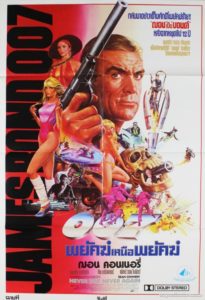 The film contains one of the best shark attack scenes in cinema, second only to Jaws, but unlike Jaws everything looks completely real and I had no idea when a real shark ended and a fake shark began. Rowan Atkinson turns up, playing a character named Nigel Small-Fawcett, in his first film role and obviously brings some humour to the film. But negatives are never far behind and I found the villains of the film to be dull and uninspired. I love Max von Sydow but his Blofeld is uninteresting, as is Largo for the most part. The Bond films have had two chances to make Largo a good villain and I feel that they’ve missed both opportunities. However, the villainous Fatima Blush is a lot of fun and feels very similar to Xenia Onatopp from Goldeneye. I wonder if the writers took inspiration from Fatima and brought it into the official canon with Xenia. The films biggest failure is the music which is usually fantastic in the Bond series. John Barry refused to do the film through loyalty to the Broccolis and the producers wanted James Horner to do the score after his amazing work on Star Trek: The Wrath of Khan. Connery however – now in a position of power – refused to hire Horner and instead hired Michel Legrand which turned out to be the wrong decision because the score is absolutely horrendous.
The film contains one of the best shark attack scenes in cinema, second only to Jaws, but unlike Jaws everything looks completely real and I had no idea when a real shark ended and a fake shark began. Rowan Atkinson turns up, playing a character named Nigel Small-Fawcett, in his first film role and obviously brings some humour to the film. But negatives are never far behind and I found the villains of the film to be dull and uninspired. I love Max von Sydow but his Blofeld is uninteresting, as is Largo for the most part. The Bond films have had two chances to make Largo a good villain and I feel that they’ve missed both opportunities. However, the villainous Fatima Blush is a lot of fun and feels very similar to Xenia Onatopp from Goldeneye. I wonder if the writers took inspiration from Fatima and brought it into the official canon with Xenia. The films biggest failure is the music which is usually fantastic in the Bond series. John Barry refused to do the film through loyalty to the Broccolis and the producers wanted James Horner to do the score after his amazing work on Star Trek: The Wrath of Khan. Connery however – now in a position of power – refused to hire Horner and instead hired Michel Legrand which turned out to be the wrong decision because the score is absolutely horrendous.
Back in 1997, MGM – who own the distribution rights to the main Eon franchise – bought ownership of Never Say Never Again, seemingly with the intent of burying it. The film looks to be out-of-print with the DVD hard to come by and the Blu-ray being rare and expensive. The rights have now reverted back meaning that the 2015 film Spectre could finally use Blofeld and, yep you guessed it, SPECTRE again. Honestly, I think I would have liked another unofficial offshoot before the rights went back to MGM/Sony, even if it was just another Thunderball remake, especially considering how long the Daniel Craig films take to be produced. For now, I guess I’ll just have to settle for Kingsman films to quench my thirst, although I still think the second one was rubbish.
Never Say Never Again has given me the opportunity to understand what’s truly important in a James Bond film. The formula, investigation, globe-trotting and action are all parts of what makes a Bond film but the most important aspect, and this may seem obvious, is the character. Other things like the music and gadgets are merely wallpaper. Set dressing. They’re recognisable and enjoyable but the core is always the character of Bond. These films are his films. That’s why they are successful. Because of Bond himself. And that’s why Never say Never Again, which lacks those surface signature aspects, is a successful Bond film. Not one of the better – in fact it’s towards the bottom of the pile – but it’s undoubtedly Bond and while it’s not part of the official Bond canon, it is just as worthy to be considered a Bond film.
So, there are my thoughts on Never Say Never Again. In a few weeks, I’ll be finishing this series with a ranking of all 25 Bond films, Never Say Never Again included. What are your thoughts on Never Say Never Again? Let me know in the comments and geek out with me about TV, movies and video-games on Twitter @kylebrrtt.




